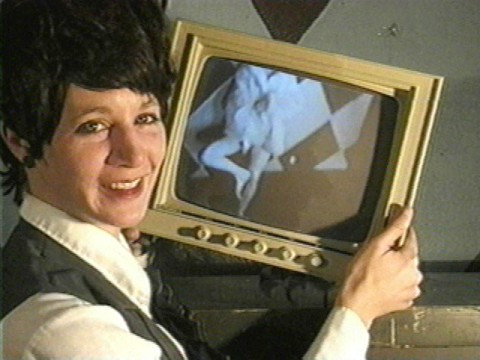Film, fiction, and photography—along with multimedia performance, experimental audio, single-channel video, and video distribution—comprise the wide-ranging scope of work by Los Angeles–based artist Miranda July. Born Miranda Jennifer Grossinger in Barre, Vermont, to writers Lindy Hough and Richard Grossinger, July grew up in Berkeley, California, where she gained regional attention for her work at the age of sixteen. While in high school, she produced The Lifers, a play based on her pen-pal relationship with an inmate in the California prison system that she staged at the legendary club 924 Gilman. She later attended and then dropped out of UC Santa Cruz to move to Portland, Oregon—ground zero for the DIY post-punk/riot grrrl scene at that time. Since then, July has carried on the ethos of that movement with nuanced, eccentric, and often collaborative works that express feminist concerns.
July has been successful in her approach from the start, as early on she supported herself with her art and is known for having not worked a “day job” since she was twenty-three years old. Upon arrival in Portland, she took up performance art in rock clubs and alternative art scenes and co-produced the fanzine Snarla. Soon after, in 1995, July began _Joanie4Jackie_ (originally called _Big Miss Moviola_), a project in which she solicited short films by women that she then compiled onto videocassettes to send back to the contributors and sell to potential viewers. She thereby created a "video chain letter" and self-fashioned film distribution center to help women artists find bigger audiences. The following year, July made the video _Atlanta_ (1996), in which she played both a twelve-year-old Olympic swimmer and her mother who speak to the public about “going for the gold”. She also recorded her first EP, _Margie Ruskie Stops Time_, with music by The Need.
From 1998 to 2000, July staged _Love Diamond_, her first "live movie” or full-length multimedia performance piece with composer Zac Love and artist Jamie Isenstein. She also exhibited a series of large-scale photographs entitled _Dot Pictures_, directed music videos for Sleater-Kinney and Blonde Redhead, and published _No One Belongs Here More Than You_, a collection of her short stories that won the 2007 Frank O'Connor International Short Story Award. Thereafter, July’s artwork has been included in exhibitions at major venues that include the Venice Biennale in 2009 and the Whitney Biennial in both 2002 and 2004. In the latter year, she presented _Learning to Love You More_ (2002–09), an online participatory arts project founded with artist Harrell Fletcher. The website proposed assignments to artists whose submissions became an evolving series of screenings, exhibitions, and radio broadcasts. July also gained international acclaim for her first feature-length film, _Me and You and Everyone We Know_, which she wrote, directed, and starred in. Released in 2005, the film went on to win the Caméra d'Or prize at the Cannes Festival and the Special Jury Prize at the Sundance Film Festival.
In much of July’s films and videos, she combines her interest in themes of desire, anxiety, loneliness, and perversion with her fascination with codes and systems. She presents various patterns of behavior, which in her view are arbitrary systems—an idea that is explicitly expressed in _The Amateurist_ (1998), in which July plays the roles of both a Professional (the "Amateurist") and an Amateur. The film offers a feminist perspective on surveillance and explores the politics and psychology of watching and being watched.
For nine to twelve hours a day, seven days a week, and four and a half years, the Professional has observed on a monitor a bored, angry, and perhaps mentally disturbed woman who wears only undergarments and a coat. Their interaction occurs awkwardly and is mediated by an obscure technique and technology, the murkiness of which is augmented by a haunting soundtrack. Specifically, the Professional suggests numbers and letters to the Amateur and analyzes the subsequent poses and gestures of her body to find similarities between the two. For instance, at one point the Professional points out that the position of the Amateur’s legs looks like the number four or a backwards seven. To explain, July has stated, "The Watcher [or Professional] has systems for life … just as you and I have systems: jobs, eating and sleeping schedules. These things feel arbitrary… [and] are all made up…. I just took out the middle, left the person, the numbers, the importance of a system”; hence, such mystifying comments as the gesture of “a hand to the hair to the eyes is…too dirty."
July appears to poke fun at the idea that the Professional is trying too hard or wasting too much time on a useless project. However, she also shows the destructiveness of her research, which is written all over the face of the Amateur. The video wavers between horror and satire in its portrayal of a woman on the brink of madness, driven there by another woman who is as oblivious to the Amateur’s despair as she is obsessed by her actions. Nonetheless, some type of bond is forged, and we witness the formation of their (highly dysfunctional) relationship. As the Professional states, “the lines get blurred,” and at times she displays her affection for the Amateur by touching or blowing onto the screen. Further, while this seems absurd or humorous, July’s performance also conveys a sense of how technology both enables and handicaps human interaction. The complex relationship between societies and modern technologies is an ongoing widespread concern, and one wonders how far removed the scenario of _The Amateurist_ is from the realities of online dating, social networking, and other forms of “surveillance,” which have become so common today. _—Kanitra Fletcher_

